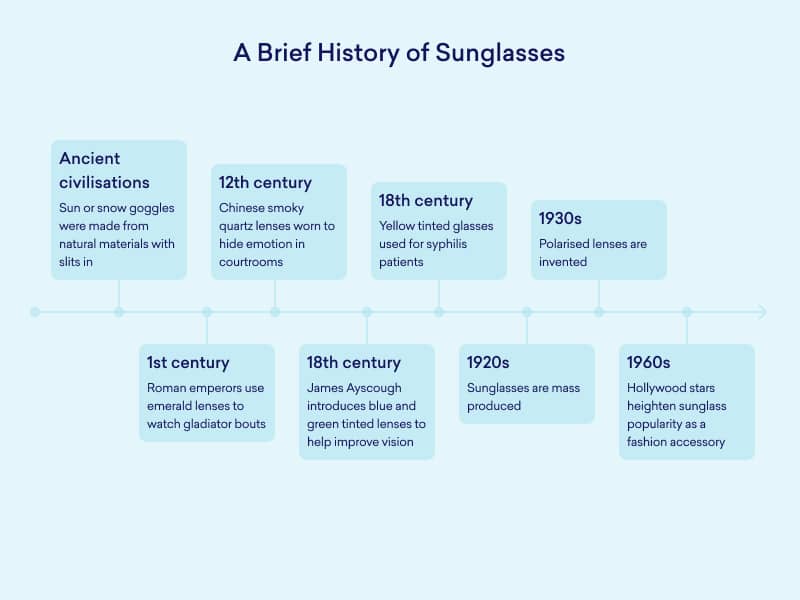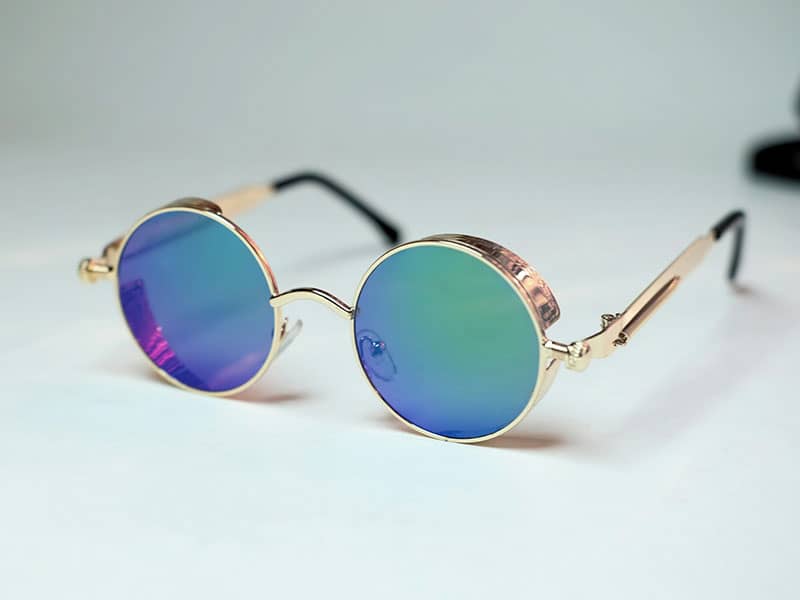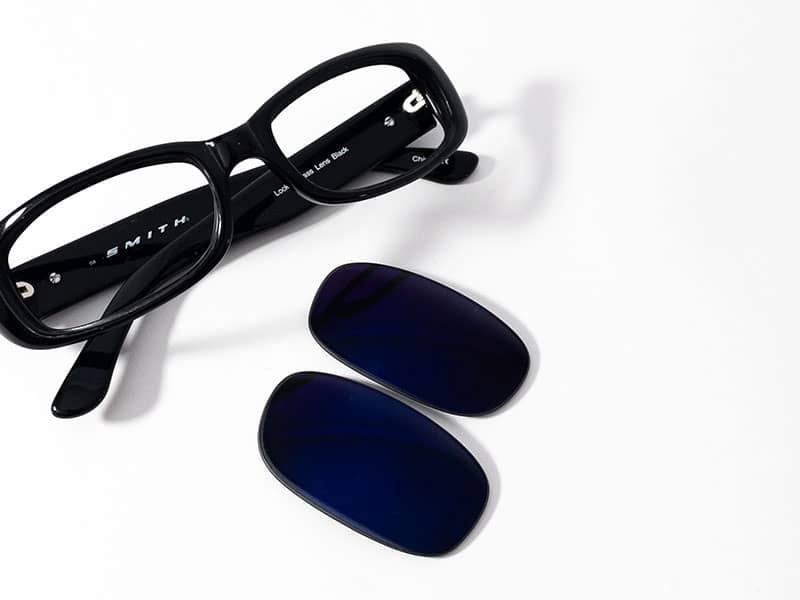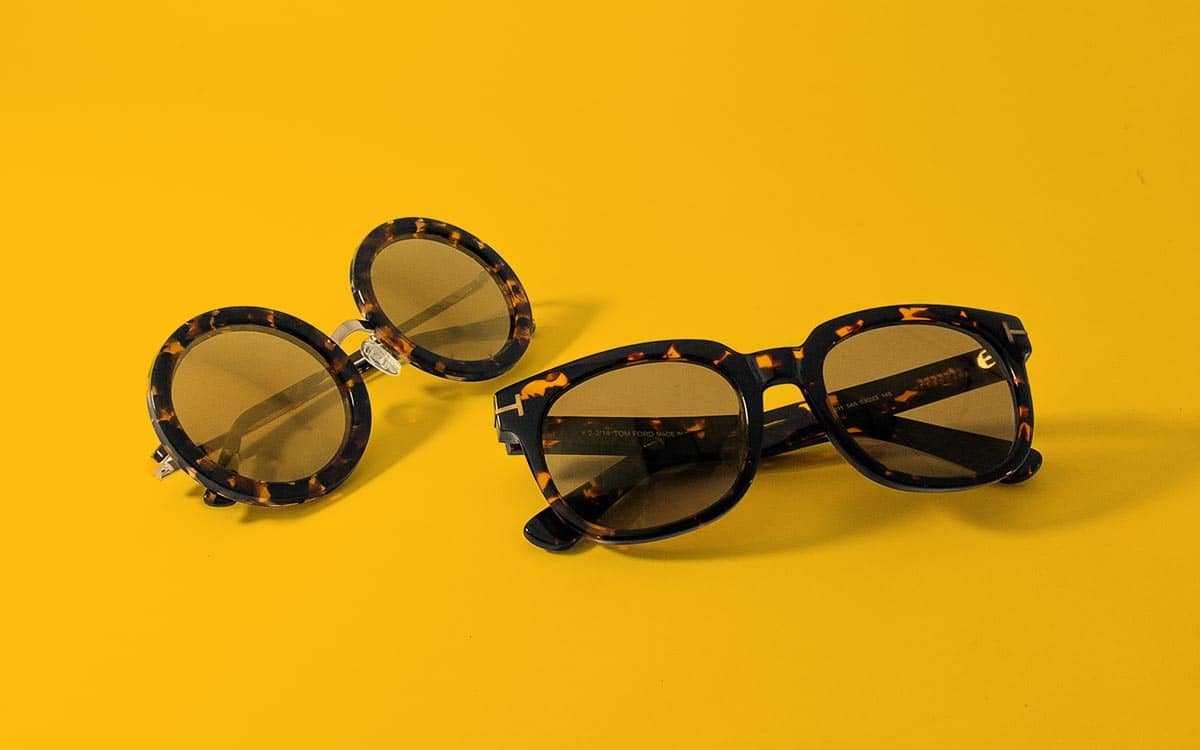Once a simple accessory for shading eyes from the sun, sunglasses have evolved into a vital contemporary tool that doubles up as a timeless fashion statement. Their development goes beyond simply addressing the practical need for eye protection; it tells a story of profound symbolism and cultural significance. In this blog post, we’ll curiously look through history to uncover their fascinating origins and, indirectly, the extensive benefits of wearing sunglasses. Let’s dive into the history of sunglasses.
Ancient History of Sunglasses
Sunglasses, as we know them today, have a heritage deeply rooted in ancient civilizations. Their evolution reflects a pragmatic response to vision problems caused by the sun, a shift in the perception of power and authority, and demonstrates evidence of scientific breakthroughs that changed lives forever.

When Were Sunglasses Invented?
Sunglasses have been integral to human life for centuries. The concept of using a device to shield our eyes from the sun's brightness predates recorded history. First-century Rome is thought to have featured emperors using lenses, but no concrete evidence of this exists.
So, when were sunglasses invented? The first confirmed appearance of sunglasses were the tinted lenses made from smoky quartz that first appeared in 12th century China. But it wasn't until the mid 1700s when a British optician began to study the benefits of tinted lenses in the medical field. Englishman James Ayscough theorized that certain visual impairments could be improved by using lenses tinted with certain shades of green or blue.
Invention of the First Sunglasses by the Inuit People
The narrative of modern sunglasses finds its roots in the ingenuity of the Inuit people, early inhabitants of the Arctic regions. Out of necessity, these resourceful individuals crafted what some regard as the first sunglasses invented using materials such as bone and ivory. More than a mere sunscreen, these early sunglasses became indispensable tools for survival, aiding the Inuit people in navigating the challenges posed by the intense sunlight reflecting off their pristine, snow-covered terrain.
Sunglasses in Ancient China and Rome
Evidence shows that judges in the courtrooms of Ancient China employed lenses made from flattened smoky quartz to protect their eyes and block court attendees from reading their facial expressions.
Meanwhile, in the opulent arenas of Rome, emperors donned lenses to see gladiator fights under the bright sun. The Roman emperor Nero, for instance, is said to have watched gladiator competitions while wearing emerald lenses, although smoky quartz and mica lenses were more the norm in Rome.
History of Sunglasses in the Middle Ages and Renaissance
Flat panels of smoky quartz or mica were still being used as lenses in the Middle Ages and Renaissance, whereas the frames developed tremendously. Bone and ivory frames were still common, but in these periods the use of horn and even gold became popular too. Straps made of leather also helped wearers to secure their lenses in place as the evolution of sunglasses began to ramp up, with their role in society evolving in the process. Elaborate designs, leather straps, and the use of precious materials marked an era where eyewear became emblematic of privilege.
Sunglasses as a Symbol of Wealth and Status
Elaborate designs and the use of precious materials during the Middle Ages and Renaissance helped sunglasses take on a new role as symbols of wealth and status. Golden frames adorned with rare stones were made for the aristocracy, showcasing both opulence and fashion. Beyond mere eye protection, sunglasses became emblems of privilege, worn by the elite to signify their elevated social standing.

Use of Tinted Lenses for Medical Purposes
After James Ayscough's initial experiments with blue and green-tinted lenses in the 1700s, the medical field expanded upon his work, discovering additional benefits of sunglasses. By the late 19th century, yellow-tinted lenses were prescribed to syphilis patients to alleviate light sensitivity, while green lenses were recommended for those with color blindness. As science advanced into the 20th century, the protective role of tinted lenses against harmful UV rays became evident. Ongoing research and technological progress in eye care continually unveil new applications of tinted lenses for medical purposes to this day..
Leonardo da Vinci's Contribution to Sunglasses
While known best for his achievements in art, science, and engineering, Leonardo da Vinci also made significant contributions to the world of sunglasses. His understanding of optics and innovative lens designs added a layer of sophistication to sunglasses, paving the way for future advancements in eyewear.
Da Vinci, acknowledging the significance of shielding eyes from intense sunlight and glare, envisioned groundbreaking lens shapes to accomplish this purpose. His forward-thinking concepts were instrumental in shaping the path of sunglasses, highlighting not only their practicality but also the fusion of science and fashion.
Modern Evolution of Sunglasses
Sunglasses underwent a remarkable transformation from a symbol of status and power to an imperative tool of daily life that could be used by the masses. But how did things get to where they are now?
Introduction of Modern Sunglasses in the 18th Century in Europe
In the 18th century in Venice, Italy first modern sunglasses with wire frames to hold green tinted lenses for sun protection were worn by gondoliers and known as Goldoni Glasses. No longer confined to the elite, sunglasses became accessible to the general public. This shift marked a significant chapter in the history of sunglasses, making them a widespread accessory.
The Rise of Sunglasses as a Fashion Accessory in the 20th Century
The 20th century witnessed another revolution in the sunglasses industry, and a lot of it was thanks to Hollywood and new technology. From iconic designs to the incorporation of polarized lenses, sunglasses became synonymous with style and would be worn by movie stars known across the land. Polarized lenses, in particular, revolutionized eye protection, reducing glare and enhancing visual clarity. Imagine if da Vinci knew the secret to how polarized sunglasses work!

Technological Advancements in Lens Technology
Ongoing technological advancements in lens materials and designs have seen sunglasses become cutting-edge tech that is stronger, lighter, and more versatile than ever before. Instead of relying on easily breakable materials like glass, bio-materials such as premium optical Polyamide and Polycarbonate are used in quality sunglass replacement lenses from Sunglass Fix.
Takeaway: Sunglasses as a Timeless Fashion Statement
Sunglasses have come a long way since their ancient origins, evolving into a must-have accessory that combines style and functionality. So, next time you put on your favorite pair of shades, remember the fascinating history behind them.
And, don’t forget that if your sunglasses are scratched or damaged you can always replace their lenses with Sunglass Fix!








